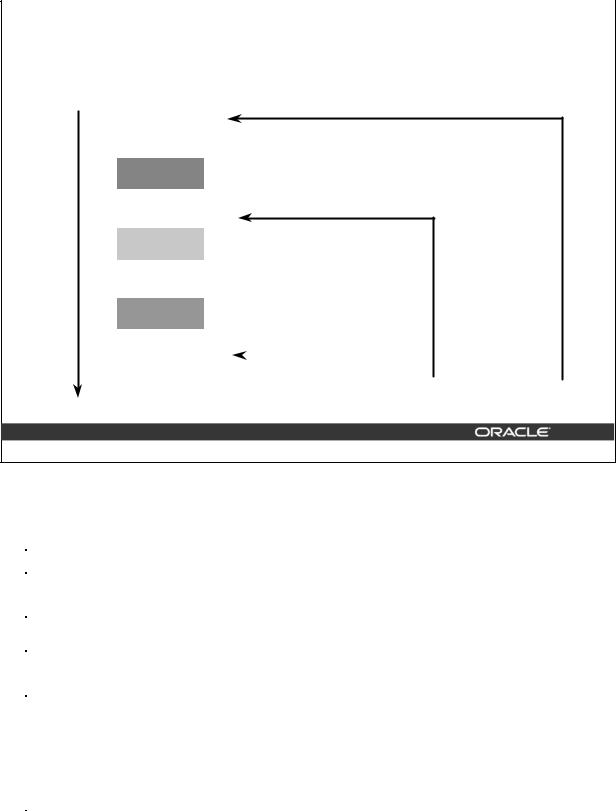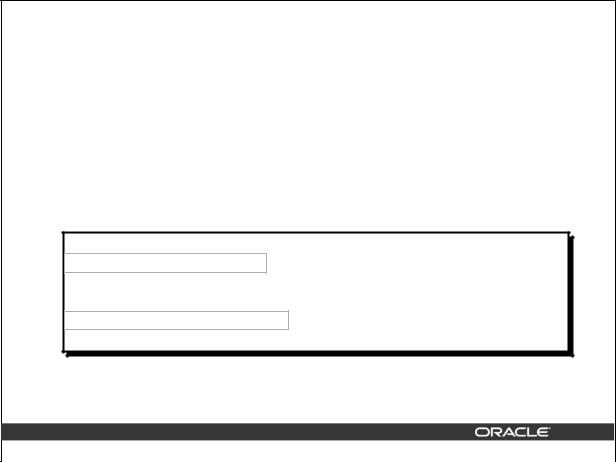
Using Explicit Default Values
•DEFAULT with INSERT:
INSERT INTO departments
(department_id, department_name, manager_id) VALUES (300, ’Engineering’, DEFAULT);
•DEFAULT with UPDATE:
UPDATE departments
SET manager_id = DEFAULT WHERE department_id = 10;
8-27 |
Copyright © Oracle Corporation, 2001. All rights reserved. |
Using Explicit Default Values
Specify DEFAULT to set the column to the value previously specified as the default value for the column. If no default value for the corresponding column has been specified, Oracle sets the column to null.
In the first example shown, the INSERT statement uses a default value for the MANAGER_ID column. If there is no default value defined for the column, a null value is inserted instead.
The second example uses the UPDATE statement to set the MANAGER_ID column to a default value for department 10. If no default value is defined for the column, it changes the value to null.
Note: When creating a table, you can specify a default value for a column. This is discussed in the “Creating and Managing Tables” lesson.
Introduction to Oracle9i: SQL Basics 8-27

The MERGE Statement
•Provides the ability to conditionally update or insert data into a database table
•Performs an UPDATE if the row exists, and an INSERT if it is a new row:
–Avoids separate updates
–Increases performance and ease of use
–Is useful in data warehousing applications
8-28 |
Copyright © Oracle Corporation, 2001. All rights reserved. |
MERGE Statements
SQL has been extended to include the MERGE statement. Using this statement, you can update or insert a row conditionally into a table, thus avoiding multiple UPDATE statements. The decision whether to update or insert into the target table is based on a condition in the ON clause.
Since the MERGE command combines the INSERT and UPDATE commands, you need both INSERT and UPDATE privileges on the target table and the SELECT privilege on the source table.
The MERGE statement is deterministic. You cannot update the same row of the target table multiple times in the same MERGE statement.
An alternative approach is to use PL/SQL loops and multiple DML statements. The MERGE statement, however, is easy to use and more simply expressed as a single SQL statement.
The MERGE statement is suitable in a number of data warehousing applications. For example, in a data warehousing application, you may need to work with data coming from multiple sources, some of which may be duplicates. With the MERGE statement, you can conditionally add or modify rows.
Introduction to Oracle9i: SQL Basics 8-28
The MERGE Statement Syntax
You can conditionally insert or update rows in a table by using the MERGE statement.
MERGE INTO table_name table_alias
USING (table|view|sub_query) alias
ON (join |
condition) |
WHEN MATCHED THEN |
UPDATE |
SET |
col1 = |
col_val1, |
col2 = |
col2_val |
WHEN NOT |
MATCHED THEN |
INSERT |
(column_list) |
VALUES |
(column_values); |
8-29 |
Copyright © Oracle Corporation, 2001. All rights reserved. |
Merging Rows
You can update existing rows and insert new rows conditionally by using the MERGE statement.
In the syntax: |
|
INTO clause |
specifies the target table you are updating or inserting into |
USING clause |
identifies the source of the data to be updated or inserted; can be a |
|
table, view, or subquery |
ON clause |
the condition upon which the MERGE operation either updates or |
|
inserts |
WHEN MATCHED | |
instructs the server how to respond to the results of the join |
condition
WHEN NOT MATCHED
For more information, see Oracle9i SQL Reference, “MERGE.”
Introduction to Oracle9i: SQL Basics 8-29

Merging Rows
Insert or update rows in the COPY_EMP table to match the EMPLOYEES table.
|
|
|
|
|
|
|
|
|
|
|
|
MERGE INTO copy_emp |
c |
|
|
|
|
|
|
|
|
|
|
|
|
|
USING employees e |
|
|
|
|
|
|
ON |
(c.employee_id = e.employee_id) |
|
|
|
WHEN |
MATCHED THEN |
|
|
|
|
|
|
|
UPDATE SET |
|
|
|
|
|
|
|
|
c.first_name |
|
= e.first_name, |
|
|
|
|
c.last_name |
|
= e.last_name, |
|
|
|
|
... |
|
|
|
|
|
|
|
|
|
c.department_id |
|
= e.department_id |
|
|
|
WHEN |
NOT MATCHED THEN |
|
|
|
|
|
|
INSERT VALUES(e.employee_id, e.first_name, e.last_name, |
|
|
|
|
|
|
|
|
|
|
e.email, e.phone_number, e.hire_date, e.job_id, |
|
|
|
|
e.salary, e.commission_pct, e.manager_id, |
|
|
|
|
e.department_id); |
|
|
|
|
|
|
|
|
|
|
|
|
|
|
|
|
|
|
|
8-30 |
|
Copyright © Oracle Corporation, 2001. All rights reserved. |
Example of Merging Rows
MERGE INTO copy_emp c
USING employees e
ON (c.employee_id = e.employee_id)
WHEN MATCHED THEN |
|
|
UPDATE SET |
|
|
c.first_name |
= |
e.first_name, |
c.last_name |
= |
e.last_name, |
c.email |
= |
e.email, |
c.phone_number |
= |
e.phone_number, |
c.hire_date |
= |
e.hire_date, |
c.job_id |
= |
e.job_id, |
c.salary |
= |
e.salary, |
c.commission_pct = |
e.commission_pct, |
c.manager_id |
= |
e.manager_id, |
c.department_id |
= |
e.department_id |
WHEN NOT MATCHED THEN |
|
|
INSERT VALUES(e.employee_id, e.first_name, e.last_name, e.email, e.phone_number, e.hire_date, e.job_id, e.salary, e.commission_pct, e.manager_id, e.department_id);
The example shown matches the EMPLOYEE_ID in the COPY_EMP table to the EMPLOYEE_ID in the EMPLOYEES table. If a match is found, the row in the COPY_EMP table is updated to match the row in the EMPLOYEES table. If the row is not found, it is inserted into the COPY_EMP table.
Introduction to Oracle9i: SQL Basics 8-30
Merging Rows
SELECT *
FROM COPY_EMP;
no rows selected
|
|
MERGE INTO copy_emp c |
|
|
|
|
|
|
USING employees e |
|
|
|
ON |
(c.employee_id = e.employee_id) |
|
|
|
WHEN |
MATCHED THEN |
|
|
|
UPDATE SET |
|
|
|
|
... |
|
|
|
WHEN |
NOT MATCHED THEN |
|
|
|
INSERT VALUES...; |
|
|
|
|
|
|
|
|
|
|
|
SELECT * |
|
|
|
|
|
|
FROM |
COPY_EMP; |
|
|
|
20 rows selected. |
|
8-31 |
|
|
Copyright © Oracle Corporation, 2001. All rights reserved. |
Example of Merging Rows (continued)
The condition c.employee_id = e.employee_id is evaluated. Because the COPY_EMP table is empty, the condition returns false: there are no matches. The logic falls into the WHEN NOT MATCHED clause, and the MERGE command inserts the rows of the EMPLOYEES table into the
COPY_EMP table.
If rows existed in the COPY_EMP table and employee IDs matched in both tables (the COPY_EMP and EMPLOYEES tables), the existing rows in the COPY_EMP table would be updated to match the
EMPLOYEES table.
Introduction to Oracle9i: SQL Basics 8-31

Database Transactions
A database transaction consists of one of the following:
•DML statements which constitute one consistent change to the data
•One DDL statement
•One DCL statement
8-32 |
Copyright © Oracle Corporation, 2001. All rights reserved. |
Database Transactions
The Oracle server ensures data consistency based on transactions. Transactions give you more flexibility and control when changing data, and they ensure data consistency in the event of user process failure or system failure.
Transactions consist of DML statements that make up one consistent change to the data. For example, a transfer of funds between two accounts should include the debit to one account and the credit to another account in the same amount. Both actions should either fail or succeed together; the credit should not be committed without the debit.
Transaction Types
Type |
Description |
|
|
Data manipulation |
Consists of any number of DML statements that the Oracle server |
language (DML) |
treats as a single entity or a logical unit of work |
|
|
Data definition language |
Consists of only one DDL statement |
(DDL) |
|
|
|
Data control language |
Consists of only one DCL statement |
(DCL) |
|
|
|
Introduction to Oracle9i: SQL Basics 8-32
Database Transactions
•Begin when the first DML SQL statement is executed
•End with one of the following events:
–A COMMIT or ROLLBACK statement is issued
–A DDL or DCL statement executes (automatic commit)
–The user exits iSQL*Plus
–The system crashes
8-33 |
Copyright © Oracle Corporation, 2001. All rights reserved. |
When Does a Transaction Start and End?
A transaction begins when the first DML statement is encountered and ends when one of the following occurs:
•A COMMIT or ROLLBACK statement is issued
•A DDL statement, such as CREATE, is issued
•A DCL statement is issued
•The user exits iSQL*Plus
•A machine fails or the system crashes
After one transaction ends, the next executable SQL statement automatically starts the next transaction.
A DDL statement or a DCL statement is automatically committed and therefore implicitly ends a transaction.
Introduction to Oracle9i: SQL Basics 8-33
Advantages of COMMIT
and ROLLBACK Statements
With COMMIT and ROLLBACK statements, you can:
•Ensure data consistency
•Preview data changes before making changes permanent
•Group logically related operations
8-34 |
Copyright © Oracle Corporation, 2001. All rights reserved. |
Introduction to Oracle9i: SQL Basics 8-34

Controlling Transactions
Time COMMIT
Transaction
DELETE
SAVEPOINT A
INSERT
UPDATE
SAVEPOINT B
|
|
|
|
|
|
|
|
INSERT |
|
|
|
ROLLBACK |
|
|
|
ROLLBACK |
ROLLBACK |
|
|
|
|
|
to SAVEPOINT B |
to SAVEPOINT A |
|
8-35 |
Copyright © Oracle Corporation, 2001. All rights reserved. |
|
Explicit Transaction Control Statements
You can control the logic of transactions by using the COMMIT, SAVEPOINT, and ROLLBACK statements.
Statement |
Description |
|
|
COMMIT |
Ends the current transaction by making all pending data changes |
|
permanent |
SAVEPOINT name |
Marks a savepoint within the current transaction |
|
|
ROLLBACK |
ROLLBACK ends the current transaction by discarding all pending |
|
data changes |
ROLLBACK TO |
ROLLBACK TO SAVEPOINT rolls back the current transaction to |
SAVEPOINT name |
the specified savepoint, thereby discarding any changes and or |
|
savepoints created after the savepoint to which you are rolling back. |
|
If you omit the TO SAVEPOINT clause, the ROLLBACK statement |
|
rolls back the entire transaction. As savepoints are logical, there is |
|
no way to list the savepoints you have created. |
Note: SAVEPOINT is not ANSI standard SQL.
Introduction to Oracle9i: SQL Basics 8-35
Rolling Back Changes
to a Marker
•Create a marker in a current transaction by using the SAVEPOINT statement.
•Roll back to that marker by using the ROLLBACK TO SAVEPOINT statement.
UPDATE...
SAVEPOINT update_done;
Savepoint created.
INSERT...
ROLLBACK TO update_done;
Rollback complete.
8-36 |
Copyright © Oracle Corporation, 2001. All rights reserved. |
Rolling Back Changes to a Savepoint
You can create a marker in the current transaction by using the SAVEPOINT statement which divides the transaction into smaller sections. You can then discard pending changes up to that marker by using the ROLLBACK TO SAVEPOINT statement.
If you create a second savepoint with the same name as an earlier savepoint, the earlier savepoint is deleted.
Introduction to Oracle9i: SQL Basics 8-36











